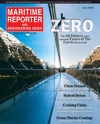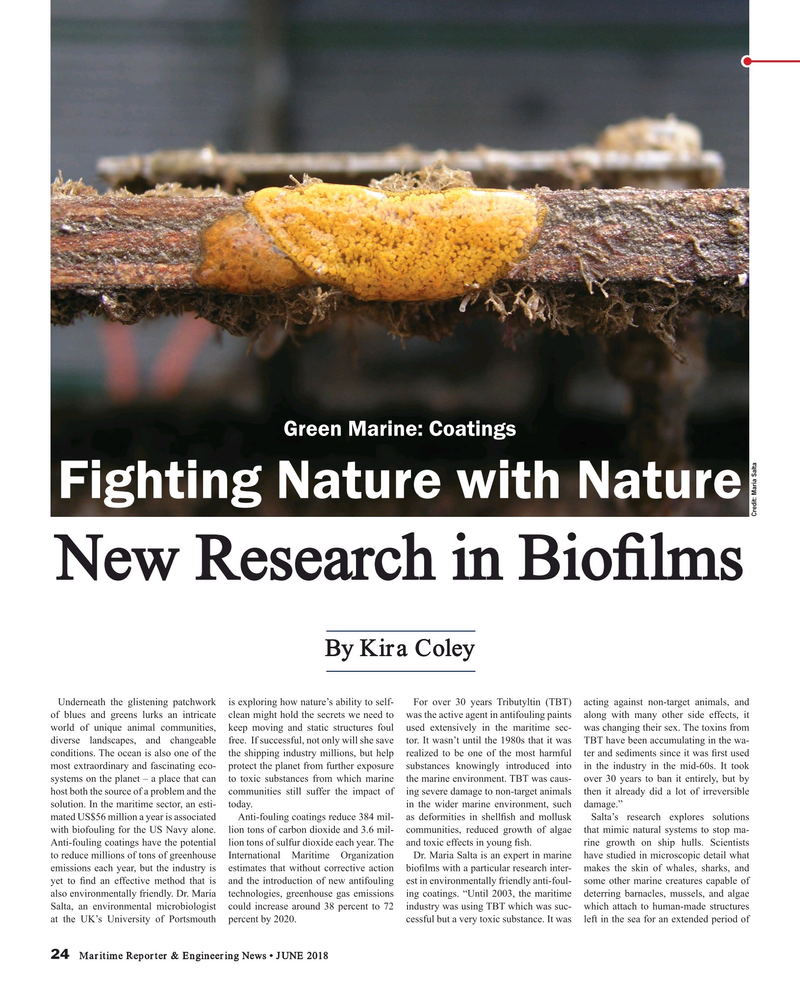
Page 24: of Maritime Reporter Magazine (June 2018)
Green Marine Technology
Read this page in Pdf, Flash or Html5 edition of June 2018 Maritime Reporter Magazine
Green Marine: Coatings
Fighting Nature with Nature
Credit: Maria Salta
New Research in Bio? lmsNew Research in Bio? lms
By Kira Coley
Underneath the glistening patchwork is exploring how nature’s ability to self- For over 30 years Tributyltin (TBT) acting against non-target animals, and of blues and greens lurks an intricate clean might hold the secrets we need to was the active agent in antifouling paints along with many other side effects, it world of unique animal communities, keep moving and static structures foul used extensively in the maritime sec- was changing their sex. The toxins from diverse landscapes, and changeable free. If successful, not only will she save tor. It wasn’t until the 1980s that it was TBT have been accumulating in the wa- conditions. The ocean is also one of the the shipping industry millions, but help realized to be one of the most harmful ter and sediments since it was ? rst used most extraordinary and fascinating eco- protect the planet from further exposure substances knowingly introduced into in the industry in the mid-60s. It took systems on the planet – a place that can to toxic substances from which marine the marine environment. TBT was caus- over 30 years to ban it entirely, but by host both the source of a problem and the communities still suffer the impact of ing severe damage to non-target animals then it already did a lot of irreversible solution. In the maritime sector, an esti- today. in the wider marine environment, such damage.” mated US$56 million a year is associated Anti-fouling coatings reduce 384 mil- as deformities in shell? sh and mollusk Salta’s research explores solutions with biofouling for the US Navy alone. lion tons of carbon dioxide and 3.6 mil- communities, reduced growth of algae that mimic natural systems to stop ma-
Anti-fouling coatings have the potential lion tons of sulfur dioxide each year. The and toxic effects in young ? sh. rine growth on ship hulls. Scientists to reduce millions of tons of greenhouse International Maritime Organization Dr. Maria Salta is an expert in marine have studied in microscopic detail what emissions each year, but the industry is estimates that without corrective action bio? lms with a particular research inter- makes the skin of whales, sharks, and yet to ? nd an effective method that is and the introduction of new antifouling est in environmentally friendly anti-foul- some other marine creatures capable of also environmentally friendly. Dr. Maria technologies, greenhouse gas emissions ing coatings. “Until 2003, the maritime deterring barnacles, mussels, and algae
Salta, an environmental microbiologist could increase around 38 percent to 72 industry was using TBT which was suc- which attach to human-made structures at the UK’s University of Portsmouth percent by 2020. cessful but a very toxic substance. It was left in the sea for an extended period of 24 Maritime Reporter & Engineering News • JUNE 2018
MR #6 (18-25).indd 24 MR #6 (18-25).indd 24 6/6/2018 9:42:40 AM6/6/2018 9:42:40 AM

 23
23

 25
25
